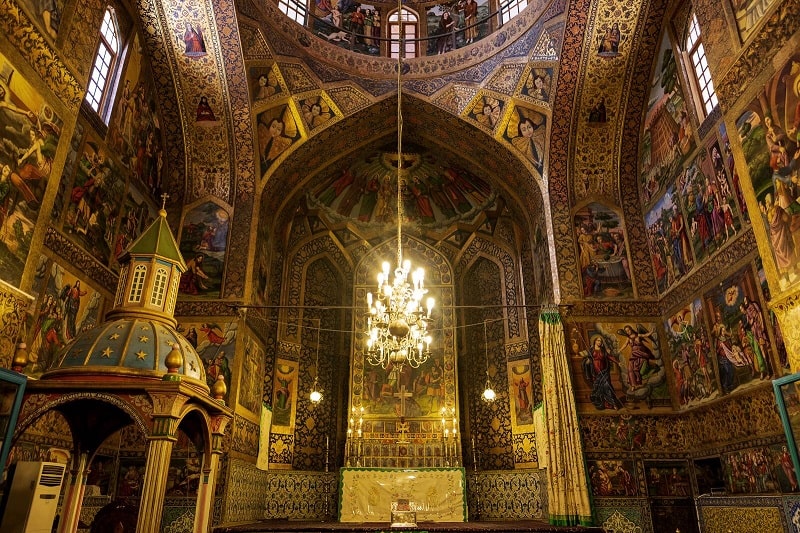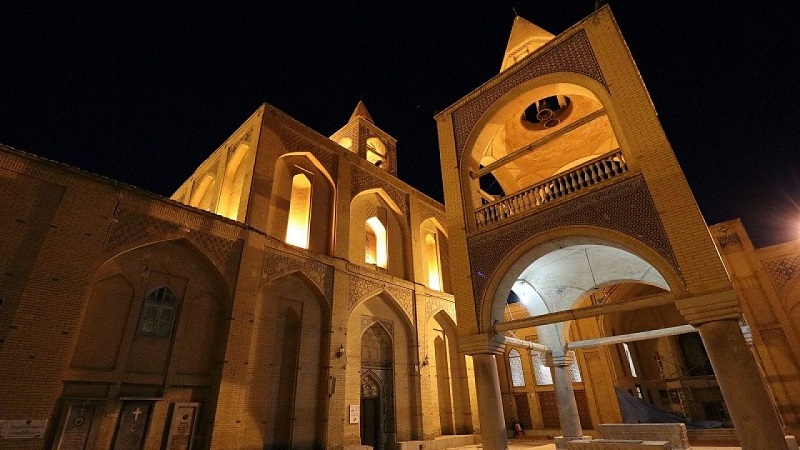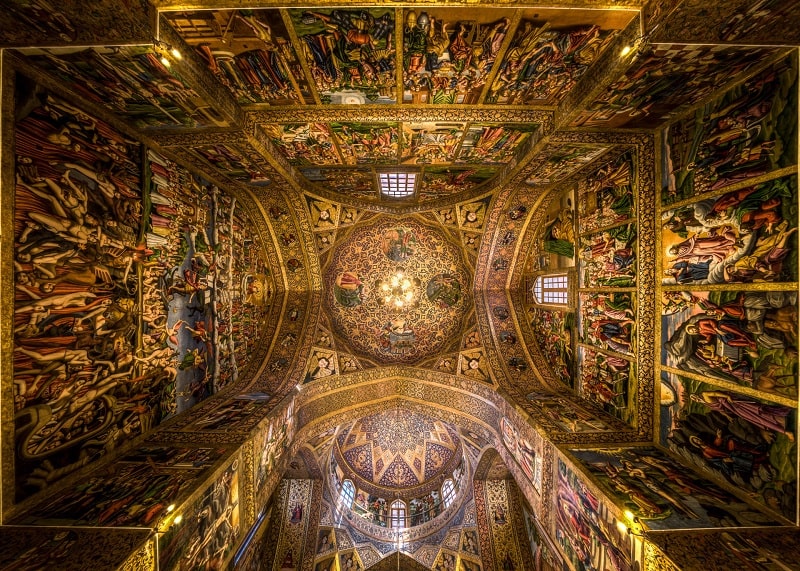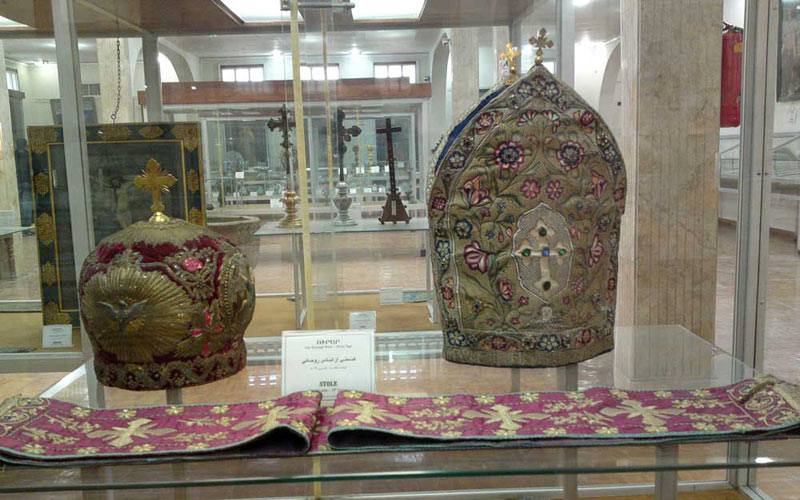Introduction to Vank Cathedral
Isfahan’s astonishment is not only for embracing half of the world’s glory but also for having a reputation as a historical and cultural land. Isfahan is full of magnificent historical monuments that are unique in the whole world. One of the stunning historical ones of this charming city is Vank cathedral, where is a small historical city itself inside the heart of a historical city as big as Isfahan. The 400-year-old Vank Church (Cathedral), the flagship of the old Julfa neighborhood, is like a shining jewel in the centre of Isfahan. The most prominent feature of the Vank Church, which combines Armenian and Persian architecture, is its frescoes, which adorn all the interiors of the sanctuary, depicting the religious stories of the Old and New Testaments through oil paints and water-gold.

History of Vank Cathedral
Vank Cathedral or Amenaprkich, meaning the Church of the Holy Savior, is the name of a church in the Julfa neighborhood of Isfahan, which is named after the church “Surb Amenaprkich Vank” in Juqa, Nakhchivan. Such a cathedral is one of the historical ones of Isfahan and was built during the reign of Shah Abbas. Vank also means monastery in Armenian. The church dates back to 1906, so its construction is more than a century old today. Vank was a small building southwest of todays’ one and was known as the Church of the Jacob. The construction of the present-day Vank Cathedral began about 50 years later, in 1655, and was completed in 1664.
Shah Abbas accompanied the Armenians on his way back to Persia; he burned all their farms and houses so that the Ottoman army would not reach them. Shah Abbas sheltered Armenians in Esfahan, and this religious minority lived in an area called Julfa. To provide living conditions for the Armenians, he ordered to build several different churches in the region. About 24 churches were built in the Julfa area, of which today we see only 13 of them. Vank Cathedral was also the first one built for this purpose. Due to its unique volume, this church became the Julfa Cathedral and was a prominent religious-political centre for Armenians as same as the present.
Vank was considered a centre for the training of priests and caliphs; being trained, many monks have reached the highest spiritual positions there. Today, the brilliant church is still active and known as the center of the caliphate and the communication centre between the Armenians of Isfahan, southern Persia, and the world.

Architecture of Vank Church
Vank Cathedral is distinctive from any other you have ever seen. To persuade the Armenians to stay in Persia, Shah Abbas granted them privileges, including the construction of churches; however, to prevent religious conflicts between Muslims and Armenians, he made terms and conditions for churches’ construction. The buildings should not be similar to other Armenian ones in Armenia, hence, Armenian artists had no choice but to build their religious buildings in the Persian architects’ style, with the appearance of mosques. Therefore, taking advantage of the artistic heritage of their land and being inspired by Persian art, they built spectacular works such as churches and luxurious mansions, examples of which can not be found anywhere in the world.
In most ancient Armenian churches, you can see the stone as the main material, but Vank Church is made of raw clay. The church’s exterior wall is covered with bricks as well as tiles painted with winged angels. The interior wall embraces plastering, with eye-catching pictures painted on it. The Vank Church is not only the symbol of more than a century of Christian history, but it is also the representative of outstanding painting art. In other words, such a building, in addition to being an interesting historical attraction, can be a unique gallery of all kinds of stunning paintings.

The domes of Vank Church
Vank Church (Cathedral) has two small and large domes. It is exactly where the fusion of Persian and European architecture comes into play. Almost none of the foreign churches contain any such domes, while the traditional churches’ ones are conical. Considering the coincidence of the year of the Cathedral’s construction with the Safavid period, a dome’s existence in the mosque architecture style makes sense. The large dome located on the main altar is a complete symbol of Persian-Islamic architecture inspired by mosques. Baked bricks have been used as the outer covering of the dome, however, its inner part is embellished with beautiful decoration and paintings. To see the church’s dome, you have to go to the western part that contains square columns with high arches and domes above.
The bell towers of Vank Cathedral in Isfahan
The first building to enter the vank, at the right of the entrance staircase, is the bell tower, which was built on three floors above the entrance but not built at the same time as the church. Interesting to know, the first bell tower of Vank cathedral was added about 38 years after the church’s construction. The church bells, which have been replaced over the years, are also kept by Armenians, possible to visit.
The Clock Tower’s name comes from a large clock weighing 300 kg on the tower’s second floor. Four circular clock screens are installed on all four sides of the tower, making the clock’s sound be heard throughout the Julfa neighborhood. Mardiros Gorg Hordanian, in memory of his brother, who died in 1924, built and donated the tower and its clock in 1931. On the roof of the church, at the top of the entrance, between the western wall and the small dome’s edge, there is a square-shaped area in which a small bell tower exists as the second bell tower of the church. The ground under the bell tower is not flat and empty, but there are two graves under it. One of these graves belongs to an Armenian soldier, and the other embraces one of the leaders of Christianity.

Paintings of Vank Church
Are you interested in traveling in the past? Don’t you think that traveling to the past, to times long before the age in which we live, is exciting?
All the walls, arches, dome collar, inside the dome, and all corners of this church are painted and embellished with oil paint. When you notice paintings that are among the best historical and artistic works in the world, you immediately feel that you have stepped into the great churches of Europe. The first assortment of paintings in the church, such as cloth paintings, are installed in the church’s sanctuary and some other parts. The second one, which is accurately placed on the walls, can be seen all over the church. The oil color paintings inside the main altar are considered as one of the most prominent features of Vank painted in 1669. Fortunately, they have not been damaged in the slightest.
In addition to the mentioned paintings, there is an interconnected painting in the church; it starts from the chamber for church objects, has a narrative mode, and depicts events continuously. As it begins with the proclamation of God’s angel to Mary, scenes such as the birth of Christ, the prostration of the three kings to Christ, the temptation of Jesus by the devil, the last supper of Jesus, his crucifixion, burial Jesus exposes the Ascension, etc. are covering the church. But the church paintings do not cease there. On the church’s north wall, there are images of the resurrection, above which is the paradise beside the entrance of the saved people. At the bottom, the hell with fire flames, the multi-headed dragon, the wall of angels, and the angels who hang sinners from above can be seen as well. Inside the church’s large dome, which is above the altar, you can also perceive paintings that tell the creation of Adam and Eve until the death of Abel’s story.
Khajeh “Audicus Stepanos” had paid for all the embellishments, paintings, and the church’s gliding. The painters were all Armenian masters, including the Khalifa Hovhannes Merkoz, Priest Stepanos, and Master Minas. The cathedral is unique among Armenian cathedrals in terms of gilding and illumination. Moreover, Khajeh Odik had a significant role in decorating and painting the walls of the church.

Vank Cathedral Museum
About a hundred years ago, a man named Thaddeus of the Greeks attempted to build rooms on the north side of the Vank cathedral courtyard to store books, manuscripts, and historical artifacts. Such an idea was the beginning of the museum’s construction, though not in its present form.
In 1977, Zavon Ayvazian, an Italian artist, created two sculptures in Italy. The two statues were donated to the Vank Museum by two charitable Armenians and installed at the entrance. The statues belong to Mesrup Mashtots, the inventor of the Armenian alphabet, and Hachatur Kesaratsi, who founded the Vank Church printing press in the 17th century.

The Armenian Genocide Martyrs Monument
There is a building in the northwestern of Vank cathedral, with dazzling architecture. The Armenian Genocide Martyrs Monument was erected by the Ottomans in 1975, on the 60th anniversary of the Armenian genocide. The building’s architecture is square-shaped, containing four columns, which meet at the top. The monument implies that the massacre begins, divides the people, but finally, it achieves unity. It was created by engineer Albert Ajamian to keep the memory of those killed in the incident alive, also to make the next generations of Armenian immigrants familiar with their origins. Every year, on April 24, at the Vank Church (Cathedral), the Armenians hold a ceremony to commemorate the martyrs, next to the monument to the Armenian Genocide Martyrs.
Vank Church Printing House
The printing industry’s advent was in the 16th century, from 1630 to 1638. Many religious leaders from different countries tried to work with this industry to print the Bible and make it available to society. Hachatur Kesaratsi, the prominent Armenian Khalifa of Julfa in Isfahan, became acquainted with the European printing industry in 1630. So, he made many efforts to bring such art and craft to Esfahan and Julfa. In 1638, the Zabur David was published as the first book in Vank Printing House, and it took a year and five months to print. In 1644, Manug Hordananian bought a printing press with all its accessories and sent it to his hometown, Julfa, Isfahan. The printing press, which is on public display today, remained untouched for several years until a printing press was established in 1672 by Gregor Hohansian, and the first book of the printing house was published in the same year. From 1770 to 1790, opposition to the printing press reached its peak and set there on fire. All that remained are some letters and forms that are now maintained in the Vank Church Museum.
Tomb of Hachatur Kesaratsi
There are the tombs of various people in the main courtyard of Vank. One of the most prominent tombs belongs to Hachatur Kasaratsi. In the 16th century, he was the Armenian Khalifa of Julfa, Isfahan, who brings the printing press to Vank Church. Due to his popularity among the Armenians of Julfa, his tomb is located in the Vank Cathedral’s courtyard.
Vank Cathedral Library
During the forced migration, the Armenians gave up everything to come to Persia but could not get past the books they had in their habitats. These valuable books’ existence led to the establishment of a library in Vank in 1884, which is located next to the present museum building, containing more than thirty thousand volumes of books in Armenian, English, Persian, etc.
The Vank Library is identified as one of the most vital centres of Armenian studies, despite the historical documents in the archive section, some of which date back more than four hundred years.

Office building
The cathedral building is the administrative office and the most important Armenian social centre in Isfahan. The building, where was built during the reign of Nasser al-Din Shah Qajar, is located in the southern part of the church. All administrative matters related to marriage, death, and birth, document preparation, and review of Armenian legal complaints accomplish in this office. The centre’s services are not only to the Armenians of Isfahan but also to the Armenians of the southern regions of Persia as well. It is interesting to know that in the past, the Vank Church office covers more areas’ works in Esfahan; even Indian Armenians traveled to Vank Church (Cathedral) to do their administrative work.

